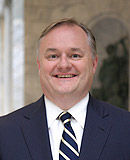If Utah School and Institutional Trust Lands Administration (SITLA) board trustee Roger E. Barrus is going to support projects like Utah State University-Moab’s future campus, he said he expects that city officials will be “reliable” partners on other developments in the community.
Barrus and other SITLA board trustees voted unanimously in January to approve a capital request for $250,000 to fund road and utility improvements to the site of the new campus off U.S. Highway 191. Before he cast his vote, however, Barrus suggested that SITLA should make it clear that it wants the City of Moab to commit to supporting all of its developments in the area, without exception.
“It’s not a negative statement saying, ‘Hey, you don’t do this, or we’re not doing this,’” Barrus said, according to an audio recording of the board’s Jan. 19 meeting. “It’s just saying, ‘This is our expectation when we work with you.’”
Another SITLA board trustee – Mike Mower – seemed to ponder whether trustees should withhold the $250,000 until the city commits to partnering more closely with the agency.
“I’m just wondering if we have a better chance of getting a partner after we’ve written a check, or before we’ve written a check,” said Mower, who also serves as the deputy chief of staff and state planning coordinator in Gov. Gary Herbert’s office.
At another point in the meeting, Barrus suggested that the USU-Moab funding could be used to leverage city support for other SITLA projects.
“We discussed this a bit in our real estate committee, and the thought is that when we go to Moab, to let them know whether or not we’re going to participate with this $250,000,” he said.
As Barrus continued to float his ideas, SITLA board chair Jim Lekas suggested that trustees should move into a closed session where they could continue their discussion out of the public’s earshot.
“I’m not sure as a non-voting person here that I’m willing to play hardball here – and I mean real hardball – on this issue here,” Lekas added.
Trustees promptly changed the subject and moved on to a subsequent agenda item. When they emerged later that afternoon from closed session, however, they cast their unanimous vote to OK the funding request, along with a diplomatically worded statement “expressing our hope that civic partners remain such and that we can work together on issues in Moab.”
The board’s discussion of the funding request came midway through the city council’s lengthy review of a zoning status agreement for the previously approved Lionsback Resort development on SITLA-owned property off Sand Flats Road. The council ultimately voted 3-2 on Feb. 28 to approve the agreement, but in the weeks leading up to that action, council members raised numerous concerns about it, creating anxiety among some SITLA officials.
Speaking to the board’s trustees, Assistant SITLA Director of Planning and Development Rodger Mitchell sent mixed signals about where the Lionsback project was headed.
“I can’t say as I stand here 100 percent that we’re going to get this under way,” Mitchell said at one point during the Jan. 19 meeting. “We’re having some serious trouble getting it through the city.”
Minutes later, however, Mitchell indicated that SITLA’s negotiations with the city were moving in a more positive direction.
“We think we have it in hand,” he said. “I don’t want to get too negative about it just yet.”
Opposition to such development, he suggested, is par for the course in Moab.
“As you probably know, developing in Moab’s like pulling teeth,” Mitchell said.
His comments drew audible laughter from the crowd, as did other remarks that criticized the city’s perceived hostility toward new development.
SITLA officials voice mixed feelings about USU-Moab project
The USU-Moab campus project is one that SITLA has long supported, and Mitchell said the agency should commit to participating at a certain level.
“And $250,000 is certainly a reasonable level,” he said.
However, Mower questioned how a $250,000 investment in infrastructure for the USU-Moab development would benefit the agency, which generates revenue for 12 state institutions, including Utah’s public schools and universities.
“What are we getting out of this as a future benefit?” Mower asked. “Because I see we’ve been stuck 10 years in a (Lionsback-related) lawsuit to develop land that we own, frankly, for a good project that would be a benefit to the community.”
When he visits the community, he said, the “big lament” he hears is that there isn’t enough affordable housing in the Moab area.
“We’re looking at putting in housing units, but we seem to be stopped at every turn,” Mower said. “Before we invest more money in there, what’s in it for the school kids?”
Mitchell said the agency should not jeopardize the opportunity for private development on SITLA land surrounding the future USU-Moab campus.
“The answer is, you don’t want to disadvantage all of this property for another property,” Mitchell said. “This is a project that the city really wants. Badly. USU will be a great campus down there. It’s a good concept.”
From SITLA’s standpoint, Barrus said he sees a benefit to the school trust in the money made through the sale of property for student housing and other future development near the campus.
“And so there is that future opportunity,” he said. “The question I keep hearing now is, ‘How do we know that we have a reliable partner in Moab that will work with us on all of these economic opportunities, rather than just the ones they want?”
Council members react to trustees’ comments
Moab City Council member Rani Derasary, who voted against the Lionsback zoning status agreement, said that she feels obligated to take a look at each proposal that comes before the council.
“It’s been my job as a council member to view every single project independently,” she told the Moab Sun News on Tuesday, March 21. “They need to recognize that we as a community need to (review) each project on its own merits.”
Moab City Council member Tawny Knuteson-Boyd, who supported the Lionsback agreeement, shares Derasary’s belief that every project has to sink or swim on its own weight.
“I don’t want to just rubber stamp any project that they come to us with,” Knuteson-Boyd said. “But I think it’s better to have a cordial working relationship with (SITLA officials), rather than an adversarial one. It just doesn’t make any sense to me to fight with each other each time an issue comes up.”
A previous city council approved the Lionsback Resort, and Mitchell said he heard that current council members were trying to leave their own mark on the project.
“It was suggested the new council doesn’t want to honor the old council,” Mitchell said. “They want to have their (own) decision.”
If it were up to the new council members, he said, they would have rejected the developer’s plan in the event that the Lionsback proposal had come to them as a new project.
“I was told, frankly, that it would be turned down,” Mitchell said.
“You’ve got one of the members (who says), ‘Don’t develop; don’t do anything,’” he added.
He suggested that SITLA could resolve the now-settled dispute over wording in the zoning status agreement through an “educational process,” including private meetings with individual council members.
Derasary said she feels uncomfortable meeting with private developers on a one-by-one basis. In this instance, she said, Moab City Attorney Chris McAnany informed her that individual meetings with SITLA officials could be considered to be inappropriate “ex parte” communications.
“I certainly didn’t meet with them because I didn’t feel that was appropriate,” she said.
Knuteson-Boyd said she believes the entire council was equally uncomfortable with the suggestion, adding that none of its members took SITLA up on the offer.
“(But) I don’t think there was any malice in their suggestion to do that,” she said.
Ultimately, she said, SITLA held two public workshops that were conducted out in the open.
“I had my questions answered,” she said.
Derasary said it’s always interesting to hear what other people assume are her preconceived notions about something. Yet she doesn’t think that SITLA officials’ perceptions of the city’s stance toward development are necessarily accurate.
“I don’t know if that commented more on the community, or the county and city specifically,” she said.
Perhaps, she said, SITLA officials are accustomed to dealing with “yes men” who go along with every project they propose.
“It’s hard (to tell) because they aren’t being more specific, but we do have engaged citizens, and maybe they find that difficult,” Derasary said.
Ex-state lawmaker questioned if USU-Moab funding could be used as leverage for council support of future development
I’m just wondering if we have a better chance of getting a partner after we’ve written a check, or before we’ve written a check.





